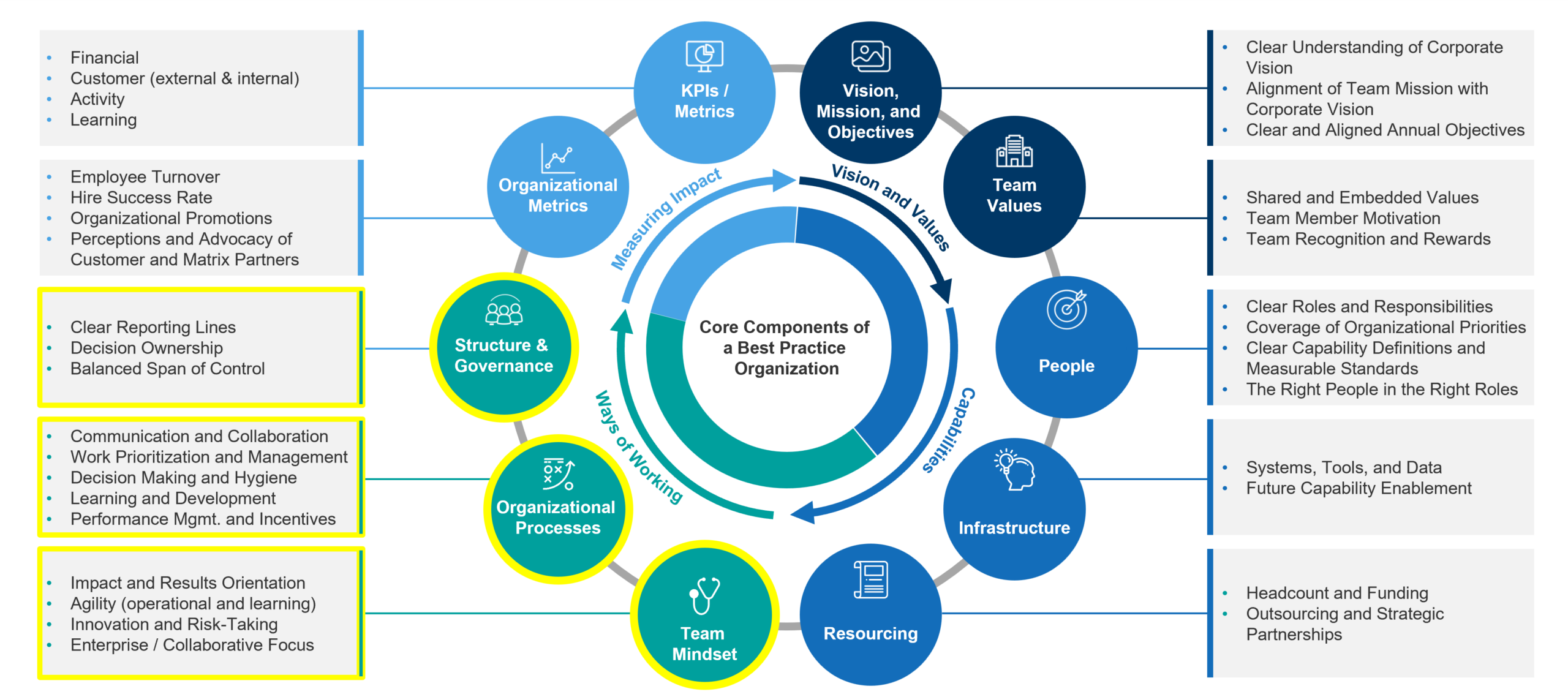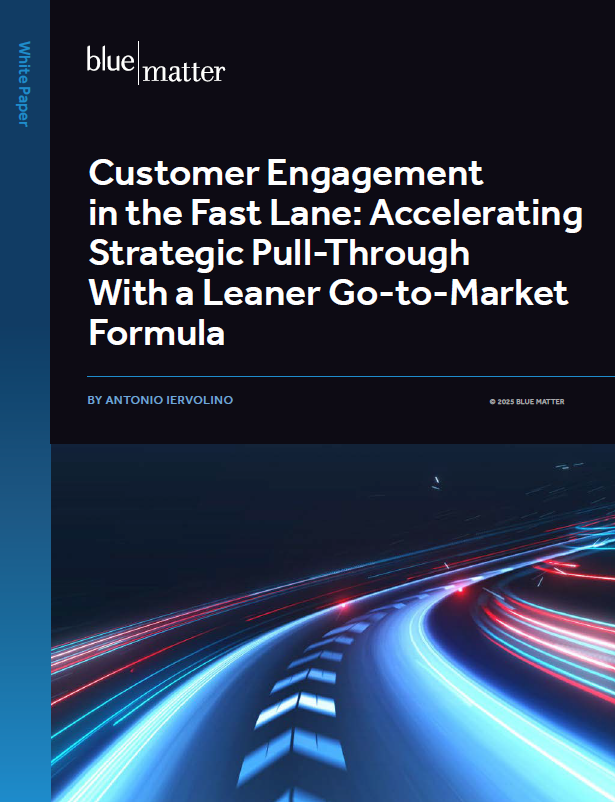
Establishing effective Ways of Working—the tangible and intangible elements of a company’s operations that tie an organization together and help it work effectively and efficiently—is an essential step for any biopharma company looking to be a Best Practice Organization (BPO).
Ways of working help team members understand how they need to do their jobs. Undefined or loose ways of working often mean teams are working in chaos, which can lead to redundant work, wasted resources, and burnout. On the other hand, restrictive ways of working lead to bureaucracy and reactive teams, which can slow down decision making, execution, and productivity. An organization is unlikely to achieve its goals without implementing effective ways of working.
Earlier articles in this series have looked at the importance for BPOs of having clear Vision, Mission, and Values and Capabilities. The concept of ways of working ties those other elements together. A company can have powerful vision, mission, and values and strong capabilities, but without clear and aligned ways of working, it will face numerous challenges and organizational friction that pose a significant risk of slowing down the team.
In this article, we look at the essential elements of ways of working: Structure and Governance, Organizational Processes, and Team Mindset.
Structure and Governance
Organizational structure and governance protocols are key tangible elements of ways of working. Companies can approach them in multiple ways, and there is no one-size-fits-all standard. Instead, each organization must decide which approach works best for it and help everybody in the company understand it.
Organizational Structure
The key components of organizational structure are area of focus, span of control and clarity of reporting lines. It can be tempting to institute a horizontal organizational structure that limits hierarchical relationships, but for complex companies in industries like biopharma, having multiple reporting layers can better support employees and improve decision-making. The appropriate span of control will vary within an organization based upon the specific function of the teams (see table below). For instance, a global new product planning team may have a low span of control, as the work is specialized and requires experience. An in-market sales team may have a high span of control due to the homogeneity of the work and roles.
A BPO balances the span of control across its teams based upon what is required, weighing and controlling for the pros and cons (e.g., making sure that managers with a high span of control have a mechanism for providing feedback and coaching to their direct reports).
| Direct Reports per Manager | ||
| Pros |
|
|
| Cons |
|
|
| Appropriate for |
|
|
BPOs are also more likely to have clear direct and indirect reporting lines that are defined, communicated, and understood by everybody in the organization. Due to the highly matrixed nature of most companies, it is critical to clarify who people report to for processes like performance reviews and career development, both directly (i.e., solid line reporting) and indirectly (i.e., dotted line reporting).
| Description |
|
|
| Appropriate for |
|
|
One other increasingly prevalent aspect of organizational structure is the question of organizing around cross-functional teams with a shared purpose (such as global development teams, global brand teams, and customer account teams) or organizing around a single functional area. In many companies, one trend (which we’ve observed come to prominence in parallel with the “agile company” movement) has been to form cross-functional teams or “squads” to drive the work. While a few adventurous companies have explored implementing direct-line reporting within these teams, members of these teams mostly report directly to their functional leads and may have some degree of indirect reporting to the team lead.
For instance, a Global Brand Team (GBT) may be led by a Global Brand Leader, who in turn reports into the Global Commercial Lead. Members of this GBT include the Global Medical Lead and Global Market Access Lead, who both report to their functional lead.
This trend helps functions collaborate to drive their most important priorities (brand development and commercialization, for example), and are a best practice.
Governance
Companies that have manageable spans of control and clear reporting lines are also more likely to have the most effective governance, defined as how an organization reviews and approves key decisions related to strategy and resources. Almost every organization has governance committees set up to make important decisions about things such as whether to progress a drug candidate along the development and commercialization process, explore and make an acquisition, and approve market-level spend across the in-line portfolio. Governance usually also focuses on spending and investments.
In horizontal organizational structures, decision-making authority can sit with many people across the organization, which can be confusing for individuals. Conversely, in extremely hierarchical companies, decisions can get stuck in multiple committees representing only the top of the org chart, leading employees to feel disenfranchised because they don’t have the power to make decisions they may actually be capable of making.
In BPOs, governance drives decision-making down to the lowest level that’s appropriate, providing guidance, guardrails (including financial), and oversight while ensuring coordination and communication along the way. Doing so not only empowers individuals and teams to make the appropriate decisions based on their roles, but it also encourages a proper amount of risk-taking, enabling idea generation and innovation from the broad base of employees while leadership manages risk.
Organizational Processes
The other major tangible way of working is the set of processes that an organization has in place. These processes grow naturally out of the organization’s structure and governance and contain several sub-components.
The first of these is decision-making and decision hygiene, which tie directly to decision ownership. BPOs don’t rely on one leader to make decisions, but instead have processes and standards that dictate who has the authority to make decisions. They set the criteria for decision-making authority and make sure that the right people are empowered to make decisions quickly based on established rationales, and then communicate those decisions to the appropriate stakeholders.
Effective communication and collaboration are another mark of a Best Practice Organization. BPOs are skilled at defining their communication flow by addressing the following questions:
- What should be shared?
- Why should it be shared (tied to overall communication objectives)?
- How should it be shared (i.e., through which channels)?
- When should it be shared?
- Who will share it?
When companies have strong communication systems in place, they’re able to share information with the appropriate stakeholders in a clear, timely, and consistent manner. BPOs also ensure that systems are in place for ongoing cross-functional and inter-functional collaboration across the organization, enabling individuals and teams to communicate with and learn from each other. The ability to capture, manage, and share knowledge so that teams aren’t constantly “reinventing the wheel,” but instead building on established knowledge and ideas, is critical to being a BPO.
How organizations prioritize work and establish management processes is also important. In developing organizations, work prioritization and management processes are often not defined, and as a result, workload is distributed inconsistently across the company. BPOs, however, make sure that they have strong strategic planning systems in place, with leadership establishing and communicating the top corporate priorities. This ties to governance and ideally includes a feedback loop, where teams identify and recommend priorities from a “bottom-up” standpoint. Leadership considers these as they define the “top-down” priorities, which are then cascaded throughout the company to align efforts. High-functioning organizations identify who is affected by these priorities and how each team can divide workload to align with them. They also evaluate their priorities on a frequent basis and find the right balance between constantly shifting priorities (which can cause chaos) and focusing on outdated priorities (which can lead to poor business performance).
Another key organizational process is learning and development. This includes identifying the appropriate level of coaching, feedback, development planning and assessment, and professional development opportunities. Lower-performing organizations often do not have clearly defined and well-structured learning and development processes or expectations, and individuals and managers must support professional growth on their own. In BPOs, those processes are defined clearly, and expectations aligned with performance management are applied across the company.
Having clear and measurable performance management standards is the final element of organizational process related to ways of working. This is important because being able to measure team performance via clear standards allows organizations to make appropriate decisions (e.g., development plans, performance improvement plans) about team members. Effective performance management that is applied consistently is an attribute of BPOs, and it can tie performance management to individual, team, and corporate incentives.
Team Mindset
Unlike the two tangible elements of ways of working, Structure & Governance and Organizational Processes, Team Mindset is an intangible factor in how organizations operate. In a BPO, team mindset helps people stay focused on the importance of the company’s larger objectives and is closely related to an understanding of Vision, Mission, and Values. Team mindset can affect an organization’s ways of working in multiple ways.
One element is impact and results orientation—how an organization emphasizes and publicizes the ways that individuals’ work connects to organizational objectives and key performance indicators (KPIs). In developing organizations, team members often focus primarily on their own day-to-day processes and don’t keep sight of the company’s larger strategic goals. In a BPO, however, all significant work activity is coordinated with and supports the larger strategic goals.
Agility is another component of team mindset. Avoiding rigidity in thinking and decision-making is key to being a BPO. While some people are tempted to stick with a plan even when faced with new information, that approach can hinder an organization’s effectiveness, especially in the fast-changing biopharma industry. People in the highest-performing organizations learn from their environment and can quickly alter their plans to adapt to new situations and market realities.
Mindset also incorporates a company’s attitude toward innovation and risk-taking. Developing organizations often see “innovation” as little more than a buzzword and have limited risk tolerance, with leaders focusing more on short-term outcomes than growth and building true value over time. Best Practice Organizations approach these elements differently. For them, innovation (that adds value) is a priority, and metrics and incentives are configured to create a culture of appropriate risk-taking.
An organization’s enterprise and collaborative focus is another key element of mindset. While developing organizations tend to focus more on individual and team outcomes, BPOs have a broader focus across the enterprise and a collaborative orientation that’s applied consistently throughout the organization. This dynamic ties in with the work prioritization discussed above, because when team members can appropriately situate their tasks within enterprise-wide priorities, they are able to prioritize the work that most aligns with them.
The final element of team mindset is alignment of incentives. In developing organizations, incentives are focused more on individuals, to the exclusion of other team and organizational objectives. For Best Practice Organizations, however, there is a clear and consistent vertical alignment across individual, team, and corporate objectives, and different teams’ incentives are aligned horizontally with each other.
Next Up
The final article in the Best Practice Organization series, Measuring Impact, is up next. In that piece, we will discuss how effective measurement is an essential component of being a BPO.








